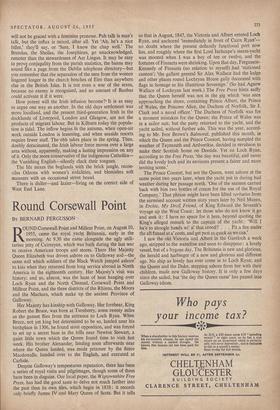Round Corsewall Point
BY BERNARD FERGUSSON OUND Corsewall Point and Milleur Point, on August 10, 1955, came the royal yacht Britannia, early in the morning. At 9.30 she came alongside the ugly utili- tarian jetty of Cairnryan, which was built during the last war to receive American troops and stores. There Her Majesty Queen Elizabeth was driven ashore on to Galloway soil—the same soil which soldiers of the Black Watch jumped ashore' to kiss when they returned from long service abroad in North America in the eighteenth century. Her Majesty's visit was history; and so, almost, was the haze of heat hanging over Loch Ryan and the North Channel, Corsewall Point and Milleur Point, and the three districts of the Rhinns, the Moors and the Machars, which make up the ancient Province of Galloway. morning. At 9.30 she came alongside the ugly utili- tarian jetty of Cairnryan, which was built during the last war to receive American troops and stores. There Her Majesty Queen Elizabeth was driven ashore on to Galloway soil—the same soil which soldiers of the Black Watch jumped ashore' to kiss when they returned from long service abroad in North America in the eighteenth century. Her Majesty's visit was history; and so, almost, was the haze of heat hanging over Loch Ryan and the North Channel, Corsewall Point and Milleur Point, and the three districts of the Rhinns, the Moors and the Machars, which make up the ancient Province of Galloway.
Her Majesty has kinship with Galloway. Her forebear, King Robert the Bruce, was born at Turnberry, some twenty miles as the gannet flies from the entrance to Loch Ryan. When Bruce, not yet king but determined to be so, landed near his birthplace in 1306, he found stout opposition, and was forced to set up a secret base in the hills near Newton Stewart, a quiet little town which the Queen found time to visit last week. His brother Alexander, landing soon afterwards near where the Queen landed, was made prisoner by the fierce Macdowalls, handed over to the English, and executed at Carlisle.
Despite Galloway's tempestuous reputation, there has been a series of royal visits and pilgrimages, though some of them have been in disguise. Our local paper, the Wigtownshire Free Press, has had the good taste to delve not much farther into the past than its own files, which begin in 1838: it records only briefly James IV and Mary Queen of Scots. But it tells us that in August, 1847, the Victoria and Albert entered Loch Ryan, and anchored 'immediately in front of Cairn Ryan'— no doubt where the present defiantly functional port now lies, and roughly where the first Lord Inchcape's steam-yacht was moored when I was a boy of ten or twelve, and the fortunes of Finnarts were shrinking. Upon that day, Fergusson- Kennedy of Finnarts (no relation to myself) had 'stationed cannon'; 'the gallant general Sir Alex Wallace had the lodge and other places round Lochryan House gaily decorated with flags in homage to his illustrious Sovereign.' (So had Agnew Wallace of Lochryan last week.) The Free Press hints sadly that the Queen herself was not in the gig which 'was seen approaching the shore, containing Prince Albert, the Prince of Wales, the Princess Alice, the Duchess of Norfolk, Sir J. Clark and a naval officer.' The Duchess of Norfolk was for a moment mistaken for the Queen; the Prince of Wales was in a sailor suit; but the party returned to the yacht, and the yacht sailed, without further ado. This was the year, accord- ing to Mr. Ivor Brown's Balmoral, published this month, in which the Queen and the Prince Consort, having sampled the weather of Taymouth and Ardverikie, decided in revulsion to make their Scottish home on Deeside. Yet on Loch Ryan, according to the Free Press, 'the day was beautiful, and never did the lovely loch and its environs present a fairer and more inviting scene.'
The Prince Consort, but not the Queen, went ashore at the same point two years later, when the yacht put in during bad weather during her passage north. 'One of the seamen carried back with him two bottles of cream for the use of the Royal Company.' That phrase might have been lifted verbatim from the surmised account written sixty years later by Neil Munro, in Erchie, My Droll Friend, of King Edward the Seventh's voyage up the West Coast: let those who do not know it go and seek it : I have no space for it here, beyond quoting the King's alleged remark to the captain of the yacht : 'Will I ha'e to shoogle hands wi' a' that crood? . . . Pit a fire under the aft funnel at a' costs, and get past as quick as we can' I saw the old Victoria and Albert in the Gareloch a week ago, stripped to the waterline and soon to disappear : a lovely vessel, but of a bygone day. The Britannia is new and glorious, the herald and harbinger of a new and glorious and different age. No ship as lovely has ever come in to Loch Ryan; and the Queen and the Duke, stepping ashore from her with their children, made new Galloway history. It is only a few days since she sailed; but 'the day the Queen came' has passed into Galloway idiom.


































 Previous page
Previous page